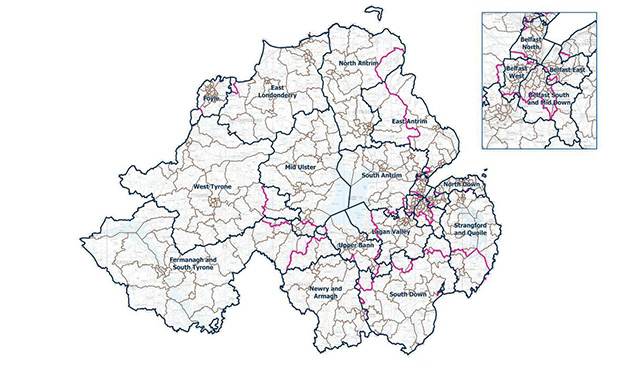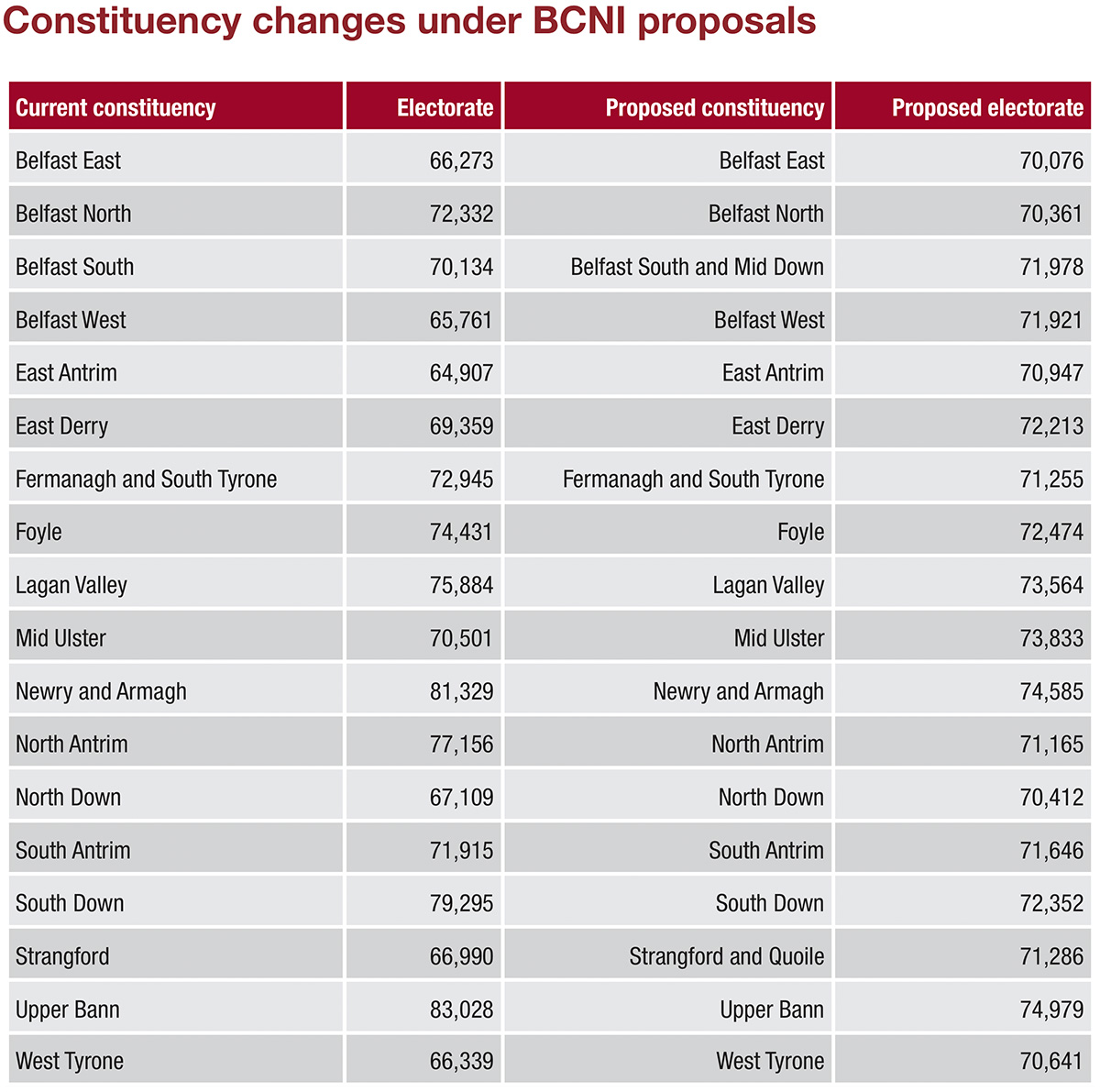Boundary Commission proposals published

The Boundary Commission for Northern Ireland has published its initial proposals for the new UK parliamentary boundaries in Northern Ireland. The proposals would see the boundaries of all 18 Westminster constituencies altered.
The Boundary Commission for Northern Ireland (BCNI) proposals have been made as part of a review across the UK and represents an attempt to align Northern Ireland with the Parliamentary Constituencies Act 1986, which states that all constituencies should be made up of electorates between 69,000 and 77,000 people. Only seven of Northern Ireland’s 18 constituencies currently meet this requirement.
Two new constituencies will also be created, with areas of South Down moving into the Belfast South and Strangford constituencies in order to create the new constituencies of Belfast South and Mid Down and Strangford and Quoile.
The proposed Belfast South and Mid Down constituency would be a borough constituency with an electorate of 71,978, as compared to the current Belfast South electorate of 70,134. The ward of Falls, which is currently split between Belfast South and Belfast West, would be placed entirely within Belfast West in this situation, with Cregagh, Hillfoot, Merok and Woodstock, which had all been split between Belfast East and Belfast South, going fully to Belfast East. Wards that had been partially located in Belfast South such as Belvoir, Blackstaff, Carryduff East, Central and Knockbracken have all been added fully to the new Belfast South and Mid Down constituency. The ward of Drumbo will also be transferred from Lagan Valley to the new constituency to satisfy population demands.
To create the county constituency of Strangford and Quoile, which will have an electorate of 71,286, the Strangford constituency, which at 66,990 voters is under the statutory requirement, will have wards transferred to it from South Down, which is over the statutory requirement with 79,295 voters. The South Down wards Cathedral, Knocknashinna, Lecale, Strangford, and Quoile (Downpatrick and its surrounds), would be transferred to the new constituency in this scenario, and the currently split wards of Crossgar and Killyleagh, Derryboy and Glen would also be aligned fully with Strangford and Quoile.
Overall, 56 wards split by the 2008 parliamentary constituency boundaries would have their constituencies altered; only two of these will still be split under these proposals: Carrowdore would go from being split between Strangford and North Down to being spit by Strangford and Quoile and North Down, as would Loughries.
BCNI is required to review the parliamentary constituency boundaries in Northern Ireland in accordance with the Parliamentary Constituencies Act 2020; these proposals were open to an eight-week public consultation, ending on 15 December 2021. BCNI is required to submit its final report with recommendations before 1 July 2023. Upon the completion of the consultation period, all representations will be published.
BCNI’s lead is High Court judge Michael Humphreys, who serves as deputy Chairman, with the Speaker of the House of Commons the Chairman. Its other two members are Sarah Havlin, a solicitor who has served various commission roles in the past, and Vilma Patterson, a construction industry veteran and former Chair of the Probation Board for Northern Ireland.
The final changes that arise from the review will be the first major changes to constituencies in Northern Ireland since 2008. Previous attempts to update the constituencies failed following legal challenges. The plans to reduce the number of parliamentary seats in Northern Ireland from 18 to 17 and from 650 to 600 overall were eventually scrapped.
The proposals have not been particularly well received across the spectrum, with Sinn Féin stating that they will challenge the moving of parts of Lurgan, and the entirety of Aghagallon and Magheralin to the Lagan Valley constituency in their submission to the consultation. Party Group Leader in Armagh, Banbridge and Craigavon Council Liam Mackle said: “We will do everything we can to ensure the Commission change their proposals. These areas are a natural part of the Lurgan area and should remain as part of the wider Upper Bann constituency where they have been since that constituency was created. The Commission need to think again.”
The DUP’s Fermanagh and South Tyrone MLA Deborah Erskine branded the plans for her area “farcical”, criticising the “nonsensical” proposed movement of wards in the Dungannon area to the Mid Ulster constituency. “Areas such as Killyman and Moygashel have a natural affinity with South Tyrone and therefore these proposals, geographically, are odd,” she said. UUP MLA Rosemary Barton also stated that she was sceptical of the proposed changes, which she described as “change for the sake of change”.
The SDLP’s MLA Mark H Durkan also spoke of local criticism in his constituency regarding plans to remove Eglinton and Claudy from the Foyle constituency. “Having spoken with individuals impacted by this restructuring it’s clear that many have concerns about the implications and have expressed their desire to remain within the Foyle constituency,” he stated.
The proposals do as they intended; they create 18 constituencies with electorates of the statutorily required size. What they do not take into account, however, is the political ramifications of the changes.
It remains to be seen which concern will win out as the parties and civil society argue their cases.






